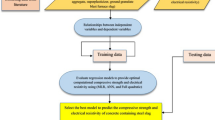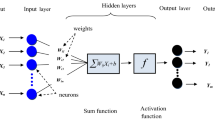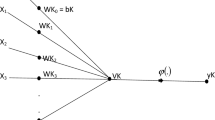Abstract
Concrete containing supplementary cementitious materials is vulnerable to carbonation. To know whether carbonation-initiated corrosion is a risk within the life span of the concrete structure, the carbonation depth should be predicted. This paper introduces an artificial neural network model for predicting the carbonation depth of slag concrete. A database was selected that consists of several subsequent research results, including nine variables as input parameters (binder content (B), slag percentage (BFS), water-to-binder ratio (W/B), slag acid index (AI), slag fineness (F), CO2 concentration (CO2), relative humidity (RH), curing time (Cure) and exposure time (Age)). The carbonation depth was considered as the output parameter of the model. The learning and validation results were found to be reliable with a correlation of 0.98. Moreover, the sensitivity check of the model agrees well with the literature. On the other hand, accelerated carbonation tests were elaborated on concretes containing 0, 20, 40 and 60% slag with W/B ratios of 0.4, 0.5 and 0.6, for 7, 28 and 90 days. The carbonation depth rises with raising slag substitution, water-to-binder ratio and time of exposure. By substituting 20–40% cement with slag, the carbonation depth is the same as that of concrete without additives for water-to-binder ratios not exceeding 0.5. Experimental validation of the developed model showed that the mean relative error is very low (MRE = 7.65%) which proves the accuracy of the ANN model. Besides, the proposed model can be used as a basic tool for service life prediction of concrete structures.







Similar content being viewed by others
References
Afshar, A., Jahandari, S., Rasekh, H., Shariati, M., Afshar, A., & Shokrgozar, A. (2020). Corrosion resistance evaluation of rebars with various primers and coatings in concrete modified with different additives. Construction and Building Materials. https://doi.org/10.1016/j.conbuildmat.2020.120034
Angst, U., Elsener, B., Larsen, C. K., & Vennesland, O. (2009). Critical chloride content in reinforced concrete—A review. Cement and Concrete Research, 39(12), 1122–1138. https://doi.org/10.1016/j.cemconres.2009.08.006
Atis, C. D. (2003). Accelerated carbonation and testing of concrete made with fly ash. Construction and Building Material, 17(3), 147–152. https://doi.org/10.1016/S0950-0618(02)00116-2
Ayat, H., Kellouche, Y., Ghrici, M., & Boukhatem, B. (2018). Compressive strength prediction of limestone filler concrete using artificial neural networks. Advanced and Computer Design, 3(3), 289–302.
Bakker, R. F. M. (1988). Initiation period Corrosion of steel in concrete (pp. 22–55). Chapman & Hall. https://doi.org/10.12989/acd.2018.3.3.289
Basheer, I. A., & Hajmeer, M. N. (2000). Artificial neural network: Fundamentals, computing design, and application. Journal of Microbiology Methods, 43, 3–31. https://doi.org/10.1016/S0167-7012(00)00201-3
Belalia Douma, O., Boukhatem, B., Ghrici, M., & Tagnit-Hamou, A. (2017). Prediction of properties of self-compacting concrete containing fly ash using artificial neural network. Neural and Computing Application, 28, 707–718.
Bier, T. A. (1986). Influence of the type of cement and curing on carbonation progress and pore structure of hydrated cement pastes. Material Research Society Symposium Proceeding. https://doi.org/10.1557/PROC-85-123
Bouikni, A., Swamy, R., & Bali, A. (2009). Durability properties of concrete containing 50% and 65% slag. Construction and Building Material, 23, 2836–2845. https://doi.org/10.1016/j.conbuildmat.2009.02.040
Boukhatem, B., Kenai, S., Ghrici, M., & TagnitHamou, A. (2010). Prévision de l’efficacité des cendres volantes dans le béton par l’utilisation d’un réseau de neurones artificiel, XXVIIIèmes Rencontres. Universitaires de Génie Civil.
Boukhatem, B., Kenai, S., Ghrici, M., & TagnitHamou, A. (2011). Prediction of efficiency factor of ground-granulated blast-furnace slag of concrete using Artificial Neural Network. ACI Materials Journal, 108(1), 55–63.
Boukhatem, B., Kenai, S., TagnitHamou, A., Ziou, D., & Ghrici, M. (2012). Optimizing a concrete mix design incorporating natural Pozzolans using Artificial Neural Networks. Computer and Concrete, 10(6), 557–573.
Boukhatem, B., Rebouh, R., Zidol, A., Chekired, M., & Tagnit-Hamou, A. (2019). An intelligent hybrid system for predicting the tortuosity of the pore system of fly ash concrete. Construction and Building Materials, 205, 274–284. https://doi.org/10.1016/j.conbuildmat.2019.02.005
Boukhatem, B., Zidol, A., & Tagnit-Hamou, A. (2021). Prediction of time-to-corrosion cracking of reinforced concrete using deep learning approach. ACI Special Publication, 349, 629–647.
Burden, D. (2006). The durability of concrete containing high levels of fly ash. PhD thesis, University of New Brunswick.
Daming, L., Ditao, N., Zhenping, D. (2014), Application of Neural Network for concrete carbonation depth prediction, Proceedings of 4th International. Conference of Durability of Concrete Structures, Purdue University, West Lafayette, IN, USA, July.
Duan, P., Shui, Z., Chen, W., & Shen, C. (2013). Enhancing microstructure and durability of concrete from ground granulated blast furnace slag and metakaolin as cement replacement materials. Journal of Materials Research Techologie, 2(1), 52–59. https://doi.org/10.1016/j.jmrt.2013.03.010
Gruyaert, E., Van den Heede, P., & De Belie, N. (2013). Carbonation of slag concrete: effect of the cement replacement level and curing on the carbonation coefficient – effect of carbonation on the pore structure. Cement and Concrete Composite, 35(1), 39–48. https://doi.org/10.1016/j.cemconcomp.2012.08.024
Houst, Y.F. (1992). Diffusion de gaz, carbonatation et retrait de la pâte de ciment durcie, PhDThesis, Ecole Polytechnique Fédérale de Lausanne.
Iranmanesh, A., & Kaveh, A. (1999). Structural optimization by gradient base neural networks. International Journal of Numerical Methods in Engineering, 46, 297–311.
Jahandari, S., Faridfazel, M., Zivari, F., Jafari, M. M., Mahmoudi, M. R., & Shokrgozar, A. (2020). The impact of long-term curing period on the mechanical features of lime-geogrid treated soils? Geomechanics and Geoengineering. https://doi.org/10.1080/17486025.2020.1739753
Jahandari, S., Saberian, M., Tao, Z., Mojtahedi, F., Li, J., Ghasemi, M., Rezvani, S., & Li, W. (2019). Effects of saturation degrees, freezing-thawing, and curing on geotechnical properties of lime and lime-cement concretes. Cold Regions Science and Technology, 160, 242–251. https://doi.org/10.1016/j.coldregions.2019.02.011
Jahandari, S., Toufigh, M. M., & Li, J. (2018). Laboratory study of the effect of degrees of saturation on lime concrete resistance due to the groundwater level increment. Geotechnical and Geological Engineering, 36, 413–424. https://doi.org/10.1007/s10706-017-0335-4
Jeyasehar, C. A., & Sumangala, K. (2006). Damage assessment of prestressed concrete beams using artificial neural network (ANN) approach. Computer and Structure, 84(26), 1709–1718. https://doi.org/10.1016/j.compstruc.2006.03.005
Jiang, L., Lin, B., & Caib, Y. (2000). A model for predicting carbonation of high-volume fly ash concrete. Cement and Concrete Research, 30(5), 699–702. https://doi.org/10.1016/S0008-8846(00)00227-1
Kaveh, A., Elmieh, R., & Servati, H. (2001a). Prediction of moment-rotation characteristic for semi-rigid connections using BP neural networks. Asian Journal of Civil Engineering, 2(2), 131–142.
Kaveh, A., Fazel-Dehkordi, & Servati, H. (2001b). Prediction of moment-rotation characteristic for saddle-like connections using BP neural networks. Asian Journal of Civil Engineering, 1(2), 11–30.
Kaveh, A., Gholipour, Y., & Rahami, H. (2008). Optimal design of transmission towers using genetic algorithm and neural networks. International Journal of Space Structures, 1(23), 1–19. https://doi.org/10.1260/026635108785342073
Kaveh, A., & Iranmanesh, A. (1998). Comparative study of backpropagation and improved counterpropagation neural nets in structural analysis and optimization. International Journal of Space Structures, 13, 177–185. https://doi.org/10.1177/026635119801300401
Kaveh, A., & Khalegi, H. A. (2000). Prediction of strength for concrete specimens using artificial neural network. Asian Journal of Civil Engineering, 2(2), 1–13.
Kaveh, A., & Rahimi Bondarabady, H. A. (2004). Wavefront reduction using graphs, neural networks and genetic algorithm. International Journal for Numerical Methods in Engineering, 60, 1803–1815. https://doi.org/10.1002/nme.1023
Kaveh, A., & Raiessi Dehkordi, M. (2003). RBF and BP Neural Networks for the analysis and design of domes. International Journal of Space Structures, 3(18), 181–194. https://doi.org/10.1680/ss5v1.31739.0051
Kaveh, A., & Servati, H. (2001). Design of double layer grids using back-propagation neural networks. Computers and Structures, 79, 1561–1568. https://doi.org/10.1016/S0045-7949(01)00034-7
Kazemi, M., Hajforoush, M., KhakpourTalebi, P., Daneshfar, M., Shokrgozar, A., & Jahandari, S. (2020). In-situ strength estimation of polypropylene fibre reinforced recycled aggregate concrete using Schmidt rebound hammer and point load test. Journal of Sustainable Cement-Based Materials, 9(5), 289–306. https://doi.org/10.1080/21650373.2020.1734983
Kellouche, Y., Boukhatem, B., Ghrici, M., & Tagnit-Hamou, A. (2017). Exploring the major factors affecting fly-ash concrete carbonation using artificial neural network. Neural Computing and Application, 31(2), 969–988. https://doi.org/10.1007/s00521-017-3052-2
Kellouche, Y., Ghrici, M., & Boukhatem, B. (2021). Service life prediction of flyash concrete using an artificial neural network. Frontier Structure and Civil Engineering. https://doi.org/10.1007/s11709-021-0717-9
Kewalramani, M. A., & Gupta, R. (2006). Concrete compressive strength prediction using ultrasonic pulse velocity through artificial neural networks. Automation in Construction, 15(3), 374–379. https://doi.org/10.1016/j.autcon.2005.07.003
Kwon, S. J., & Song, H. W. (2010). Analysis of carbonation behavior in concrete using neural network algorithm and carbonation modeling. Cement and Concrete Research, 40(1), 119–127. https://doi.org/10.1016/j.cemconres.2009.08.022
Litvan, G.G. and Meyer, A. (1986). Carbonation of granulated blast furnace slag cement concrete during twenty years of field exposure, Proceedings of the 2nd International Conference on Fly Ash, Silica Fume, Slag and Natural Pozzolna in Concrete., Madrid.
Lu, C., & Liu, R. (2009). Predicting carbonation depth of prestressed concrete under different stress states using Artificial Neural Network. Advances in Artificial Neural Systems, 9, 1–9. https://doi.org/10.1155/2009/193139
Mehrabi, P., Shariati, M., Kabirifar, K., Jarrah, M., Rasekh, H., Trung, N. T., Shariati, A., & Jahandari, S. (2021). Effect of pumice powder and nano-clay on the strength and permeability of fiber-reinforced pervious concrete incorporating recycled concrete aggregate. Construction and Building Materials. https://doi.org/10.1016/j.conbuildmat.2021.122652
Najjar, Y., & Zhang, X. (2000). Characterizing the 3D stress-strain behavior of sandy soils: A neuro- mechanistic approach. Numerical Methods Geotechnic Engineering. https://doi.org/10.1061/40502(284)4
Ojha, V. K., Abraham, A., & Snásel, V. (2017). Metaheuristic design of feedforward neural networks: A review of two decades of research. Engineering Application Artificiel Intelligence, 60, 97–116. https://doi.org/10.1016/j.engappai.2017.01.013
Osborne, G. J. (1986). Carbonation of blast-furnace slag cement concretes. Durability Building Materials, 4(1), 81–96.
Osborne, G.J. (1989). Carbonation and permeability of blast-furnace slag cement concretes from field structures, Proceedings of the 3rd International Conference of Fly Ash. Silica Fume, Slag and Natural Pozzolana Concrete, Trondheim.
Osborne, G. J. (1999). Durability of Portland blast-furnace slag cement concrete. Cement and Concrete Composite, 21(1), 11–21. https://doi.org/10.1016/S0958-9465(98)00032-8
Otair, M.A. and Salameh, W.A. (2016). Comparative Study between different versions of the backpropagation and optical backpropagation. Revista online University of PETRA, pp. 1–5.
Pal, S. C., Mukherjee, A., & Pathac, S. R. (2003). Investigation of hydraulic activity of ground granulated blast furnace slag in concrete. Cement Concrete Research, 33, 481–1486. https://doi.org/10.1016/S0008-8846(03)00062-0
Papadakis, V. (2000). Effect of supplementary cementing materials on concrete resistance against carbonation and chloride ingress. Cement and Concrete Research, 30(2), 291–299. https://doi.org/10.1016/S0008-8846(99)00249-5
Papadakis, V., Vayenas, C., & Fardis, M. (1991). Physical and chemical characteristics affecting the durability of concrete. ACI Materials Journal, 88(2), 186–196.
Parichatprecha, R., & Nimityongskul, P. (2009). Analysis of durability of high-performance concrete using artificial neural networks. Construction and Building Materials, 23(2), 910–917. https://doi.org/10.1016/j.conbuildmat.2008.04.015
Parrott, L. J. (1996). Some effects of cement and curing upon carbonation and reinforcement corrosion in concrete. Materials and Structures, 29(3), 164–173.
Parthiban, T., Ravi, R., Parthiban, G. T., Srinivasan, S., Ramakrishnan, K. R., & Raghavan, M. (2005). Neural network analysis for corrosion of steel in concrete. Journal of Corrosion Science Engineering, 47(7), 1625–1642. https://doi.org/10.1016/j.corsci.2004.08.011
Peng, J., Li, Z., & Ma, B. (2002). Neural network analysis of chloride diffusion in concrete. Journal of Materials Civil Engineering, 14(4), 327–333. https://doi.org/10.1061/(ASCE)0899-1561(2002)14:4(327)
Rasekh, H., Joshaghani, A., Jahandari, S., Aslani, F., & Ghodrat, M. (2020). Rheology and workability of SCC, self-compacting concrete: Materials. Propertiesand Applications Woodhead Publishing Series in Civil and Structural Engineering. https://doi.org/10.1016/B978-0-12-817369-5.00002-7
Rebouh, R., Boukhatem, B., Ghrici, M., & Tagnit-Hamou, A. (2017). A practical hybrid NNGA system for predicting the compressive strengthof concrete containing natural pozzolan using an evolutionary structure. Construction and Building Materials, 149, 778–789. https://doi.org/10.1016/j.conbuildmat.2017.05.165
Rofooei, F. R., Kaveh, A., & MasteriFarahani, F. (2011). Estimating the vulnerability of concrete moment resisting frame structures using artificial neural networks. International Journal of Operational Research, 3(1), 433–448.
Rumelhart, D. E., & McClelland, J. L. (1986). Parallel distributed processing—Volume 1: Explorations in the microstructure of cognition: Foundations. The MIT Press.
Saberian, M., Jahandari, S., Li, J., & Zivari, F. (2017). Effect of curing, capillary action, and groundwater level increment on geotechnical properties of lime concrete: Experimental and prediction studies. Journal of Rock Mechanics and Geotechnical Engineering, 9(4), 638–647. https://doi.org/10.1016/j.jrmge.2017.01.004
Sadeghian, F., Haddad, A., Jahandari, S., Rasekh, H., & Ozbakkaloglu, T. (2020). Effects of electrokinetic phenomena on the load-bearing capacity of different steel and concrete piles: A small-scale experimental study. Canadian Geotechnical Journal. https://doi.org/10.1139/cgj-2019-0650
Senthil Kumar, A. R., Sudheer, K. P., Jain, S. K., & Agarwal, P. K. (2004). Rainfall-runoff modelling using artificial neural networks: Comparison of network types. Hydrological Processes, 19(6), 1277–1291. https://doi.org/10.1002/hyp.5581
Shaik, H., Dipendu, B., Singh, S. B., & Mohit, A. (2018). Mechanical strength and durability of mineral admixture concrete subjected to accelerated carbonation. Journal of Structural Integrity and Maintenance, 3(1), 44–51. https://doi.org/10.1080/24705314.2018.1426170
Shi, H. S., Xu, B. W., & Zhou, X. C. (2009). Influence of mineral admixtures on compressive strength, gas permeability and carbonation of high-performance concrete. Construction and Building Materials, 23(5), 1980–1985. https://doi.org/10.1016/j.conbuildmat.2008.08.021
Siddique, R. (2008). Wast materials and by products in concrete. Engineering Materials (1st ed.)
Sisomphon, K., & Franke, L. (2007). Carbonation rates of concretes containing high volume of pozzolanic materials. Cement and Concrete Research, 37(12), 1647–1653. https://doi.org/10.1016/j.cemconres.2007.08.014
Sulapha, P., Wong, S. F., Wee, T. H., & Swaddiwudhipong, S. (2003). Carbonation of concrete containing mineral admixtures. ASCE Journal of Materials Civil Engineering, 5(2), 134–143. https://doi.org/10.1061/(ASCE)0899-1561(2003)15:2(134)
Swamy, R.N. (1997). Desing for Durability and Strength Through the Use of Fly Ash and Slag in Concrete, CANMET/ACI International Workshop on Supplementary Cementing Materials, Superplastizers and Other Chemical Admixtures in Concrete, Toronto, Canada.
Ta, V. L., Bonnet, S., Senga Kiesse, T., & Ventura, A. (2016). A new meta-model to calculate carbonation front depth within concrete structures. Construction and Building Materials, 129, 172–181. https://doi.org/10.1016/j.conbuildmat.2016.10.103
Taffese, W. Z., Sistonen, E., & Puttonen, J. (2015). CaPrM: Carbonation prediction model for reinforced concrete using machine learning methods. Construction and Building Materials, 100, 70–82. https://doi.org/10.1016/j.conbuildmat.2015.09.058
Thiéry, M. (2005). Modélisation de la carbonatation atmosphérique des matériaux cimentaires, Prise en compte des effets cinétiques et des modifications microstructurales et hydriques. PhD Thesis, ENPC, Champs sur Marne, France.
Thomas, M. D. A., Osborne, G. J., Matthews, J. D., & Cripwell, J. B. (1990). A comparison of the properties of OPC, PFA and GGBS concretes in reinforced concrete tank walls of slender section. Magazine of Concrete Research, 44(152), 127–134. https://doi.org/10.1680/macr.1990.42.152.127
Toghroli, A., Mehrabi, P., Shariati, M., Trung, N.T., Jahandari, S., & Rasekh, S. (2020). Evaluating the use of recycled concrete aggregate and pozzolanic additives in fiber-reinforced pervious concrete with industrial and recycled fibers. Construction and Building Materials. https://doi.org/10.1016/j.conbuildmat.2020.118997
Tuutti, K. (1982). Corrosion of steel in concrete. Swedish Cement Concrete Research Institut.
Yan, L., Zhao, S., & Yi, C. (2008). The Forecast of Carbonation Depth of Concrete Based on RBF Neural Network. Second International Symposium on Intelligent Information Technology Application, 3, 544–548. https://doi.org/10.1109/IITA.2008.402
Younsi, A., Turcry, Ph., Aït-Mokhtar, A., & Staquet, S. (2013). Accelerated carbonation of concrete with high content of mineral additions: Effect of interactions between hydration and drying. Cement and Concrete Research, 43, 25–33. https://doi.org/10.1016/j.cemconres.2012.10.008
Zhang, P., & Li, Q. (2013). Effect of fly ash on durability of high-performance concrete composites. Research Journal Application Science Engineering Technolgy, 6(1), 7–12. https://doi.org/10.19026/rjaset.6.4026
Zhang, X., Zhou, X., Zhou, H., Gao, K., & Wang, Z. (2013). Studies on forecasting of carbonation depth of slag high performance concrete considering gas permeability. Application Clay Science, 79, 36–40. https://doi.org/10.1016/j.clay.2013.02.020
Author information
Authors and Affiliations
Corresponding author
Ethics declarations
Conflict of interest
The authors declare that they have no conflict of interest.
Additional information
Publisher's Note
Springer Nature remains neutral with regard to jurisdictional claims in published maps and institutional affiliations.
Rights and permissions
About this article
Cite this article
Kellouche, Y., Boukhatem, B., Ghrici, M. et al. Neural network model for predicting the carbonation depth of slag concrete. Asian J Civ Eng 22, 1401–1414 (2021). https://doi.org/10.1007/s42107-021-00390-z
Received:
Accepted:
Published:
Issue Date:
DOI: https://doi.org/10.1007/s42107-021-00390-z




